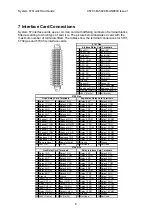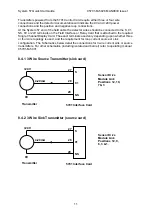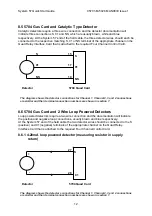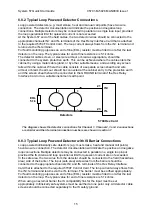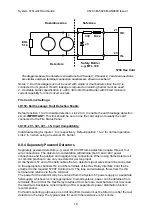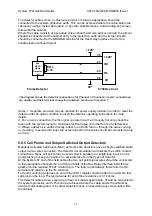
System 57 Quick Start Guide
05701-M-5026 MAN0839 Issue 1
10 Special Conditions For Safe Use.
ACCORDING TO EC-TYPE EXAMINATION CERTIFICATE BVS 04 ATEX G 001 X
The following special properties have to be considered at operation of the control unit:
-
When operated with remote detectors with 4-20mA interface the specifications of the 4-20mA interface and the
behaviour below 4mA and above 20mA have to be considered.
- The parameters “A/D-average” and “signal filter” shall be set to the detector-specific default values. Other
settings shall only be used in exceptional, justified circumstances and with the manufacturer’s permission. For
both parameters, the lowest settings shall be used which are possible for the application.
- When configuring the control cards, the detector specific default settings should be used for the error codes
“ER80”, “ER81”, “ER87” and “ER88” (parameters “signal over range”, “signal under range”, “fault over range”
and “fault under range”).
- The error codes “ER87”, “ER88” and “ER81” (parameters “fault over range”, “fault under range” and “signal
under range”) shall be set latching.
- When operated with remote detectors (e.g. Sensepoint) which may deliver signals within the measuring range
at concentrations above the measuring range, the error code “ER80” (parameter “signal over range”) shall be
set latching. If the parameter is set below the default value all alarm relays shall be configured in such a way
that alarming also takes place in the presence of detector faults.
- For remote detectors with 4-20mA interface the parameters “signal over range” and “fault over range” shall be
set in such a way that during normal operation (including the application of 100 % gas to the remote detector)
“ER80” can be activated but not “ER87”.
- The analogue outputs should be operated with live zero (4-20mA setting). The “< 4mA clipping” feature should
be activated only in exceptional cases. Irrespective of the operating mode of the analogue output, the “fault
level” and “inhibit level” shall be configured to different values outside the measuring range. The signaling of
faults and inhibits at the analogue output shall be activated.
- If no local inhibit relays are configured, a master inhibit relay shall be configured.
- If no local fault relays are configured, a master fault relay shall be configured.
- When relays are used for signaling update alarms, no other alarms or messages must be allocated to them.
Configuration of update messages for “inhibit” should be avoided.
- Time delayed relays shall not be used.
- The status of the control unit obtained via Modbus shall be used only for the purpose of visualisation or
documentation but not for safety purposes. Write access via Modbus shall be avoided. This certificate is
concerned solely with information which can be obtained from Modbus functions 02 and 04.
- When a control card 5701 is configured for master or voted alarms as well as master or voted fault or inhibit
messages, high integrity relay cards should be used. If no high integrity relay cards are used, triple relay cards
shall be used. In such cases, both the relays and the LEDs of this control card will reflect only the status of the
master or voting group. For an “X out of Y” linkage with vote counts (X) > 1, local alarms or messages of this
control card are not displayed if less than X control cards have entered the alarm, fault or inhibit status,
respectively. Therefore, voting groups have to be configured in such a way that vote counts of “1” are used for
voted faults and inhibit messages to allow for signaling of local fault and inhibit states of the control card.
- Relay 1 of a high integrity relay card is always assigned to a local fault. It is also used for signaling malfunction
of the high integrity relay card itself. Therefore, this relay shall be monitored for each high integrity relay card.
22

